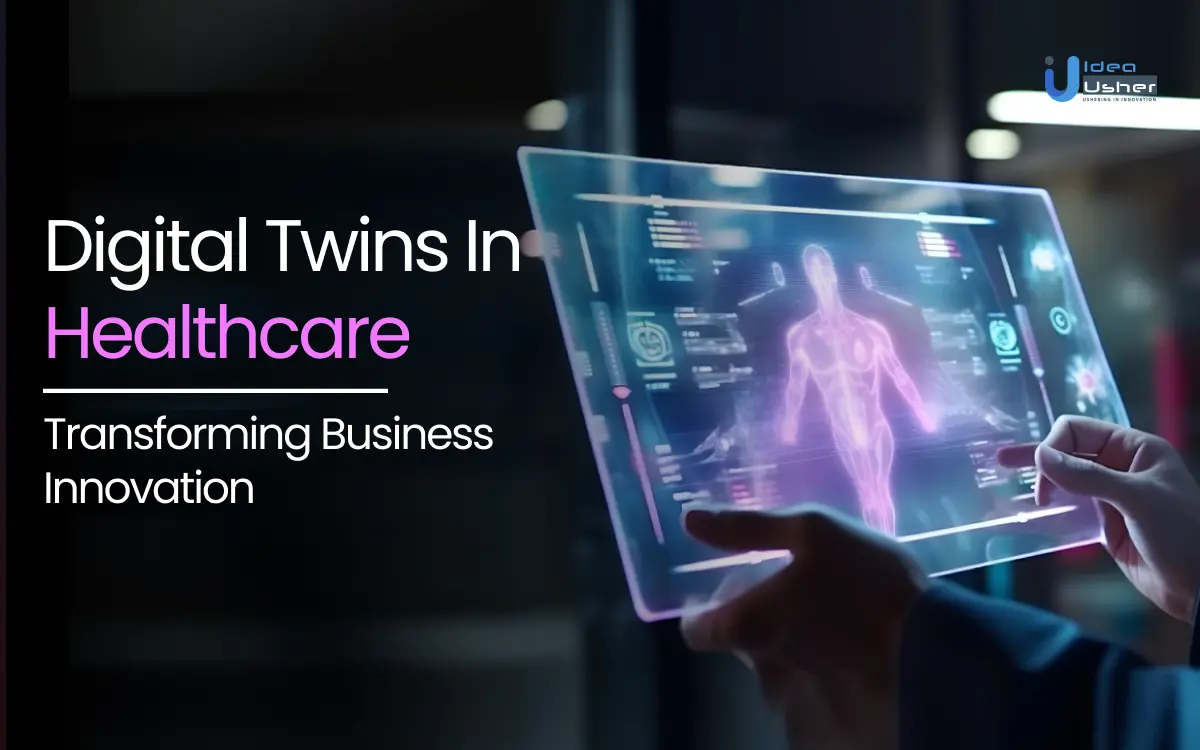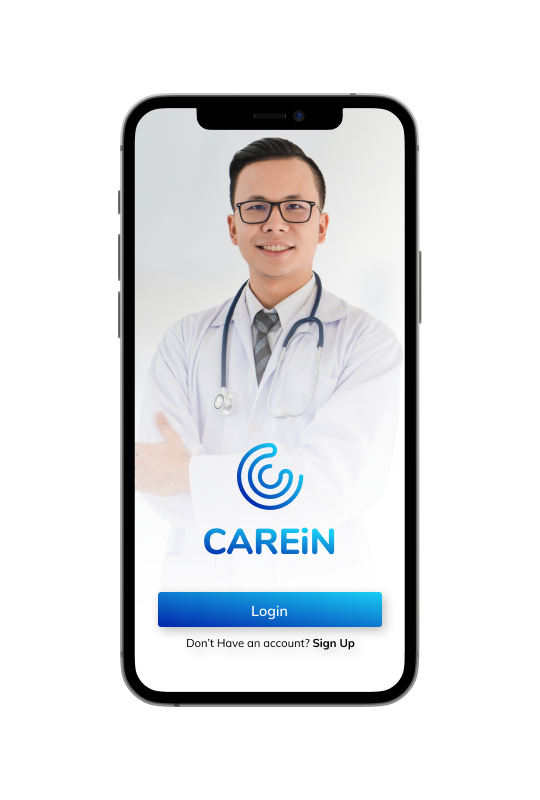Businesses in the healthcare industry, are looking for innovative tools to streamline operations, enhance patient experiences, and gain a competitive edge. Digital twins in healthcare, a powerful emerging technology, hold the promise of transforming the way we operate. Imagine a virtual replica of a patient, medical device, or even an entire healthcare system continuously updated with real-world data. This opens up a world of unparalleled analysis, simulation, and optimization, paving the way for a brighter future in healthcare.
This guide will delve into the strategic benefits of digital twins in healthcare. We’ll explore how they can redefine personalized care, enhance operational efficiency, and drive new revenue opportunities for your business. We’ll also address practical considerations to ensure the successful implementation of this transformative technology.
Market Analysis Of Digital Twins in Healthcare
The adoption of digital twins in healthcare is accelerating as hospitals, med-tech companies, and research institutions shift toward data-driven care. The global digital twin market in healthcare was valued at an estimated USD 1.2 billion in 2024, and is projected to reach USD 16–18 billion by 2030, driven by the rapid rise of AI-powered diagnostics, personalized medicine, and virtual patient simulations.
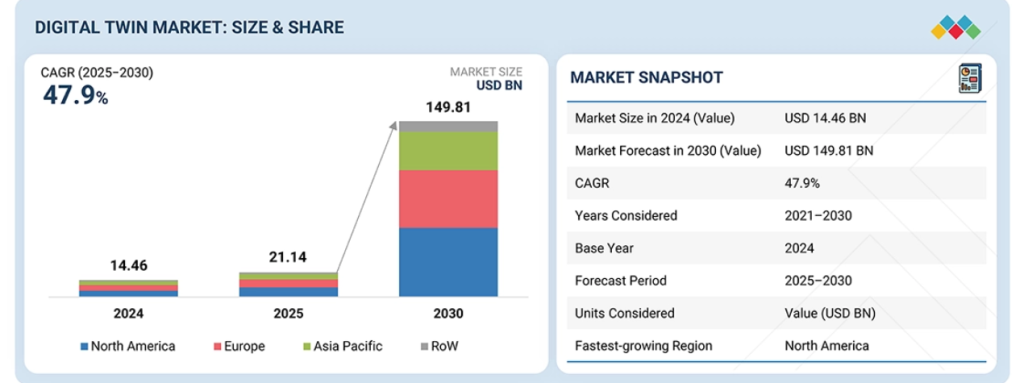
Several factors are fueling this growth:
- Increased integration of IoT devices and remote monitoring systems
- Demand for predictive analytics in hospital operations
- Rising use of virtual models for surgery planning and therapy evaluation
- Significant investments from pharma companies in digital twin-based drug development
Market adoption is expected to grow most rapidly in surgery planning, cardiology, critical care, and hospital operations management.
Understanding the Technology Behind Digital Twins
Let’s delve into the technological foundation that enables this innovation:
Data
Digital twins in healthcare draw on an incredibly diverse set of data. Beyond traditional sources like EHRs and imaging, they integrate real-time sensor data from medical devices and wearables, genomic information, behavioral and lifestyle data from mobile health apps, and even data about a patient’s environment or hospital facilities.
Real-Time Connectivity
The Internet of Things (IoT) provides the critical link between the physical and digital worlds. Embedded sensors within medical devices, patient wearables, and even ‘smart’ hospital rooms ensure a continuous flow of data, enabling the digital twin to constantly update and maintain an accurate reflection of its real-world counterpart.
Modeling & Simulation
Powerful mathematical models and simulation tools form the heart of the digital twin. These models can replicate the complex functions and behaviors of a patient’s physiology, predict how a medical device might perform under certain conditions, or simulate the flow of patients through a healthcare facility.
Artificial Intelligence
AI plays an indispensable role. Machine learning algorithms analyze the vast amounts of data flowing into the digital twin, identify patterns invisible to the human eye, predict future outcomes, and suggest optimal treatment plans or process improvements. AI capabilities enable personalization and predictive healthcare delivery.
Visualization
Advanced visualization technologies, including augmented reality (AR) and virtual reality (VR), provide intuitive ways for healthcare providers to interact with the digital twin. VR can allow a surgeon to visualize an intricate surgical procedure before stepping into the operating room. At the same time, AR tools can overlay a patient’s digital twin with real-time data during an examination.
Real-World Case Studies of Digital Twins in Healthcare
While the concept is still emerging, multiple organizations have already proven the value of digital twins in real clinical environments.
Case Study 1: Philips – Virtual Heart Twin
Philips created a patient-specific digital heart model that helps cardiologists simulate blood flow, evaluate arrhythmia risks, and test treatment outcomes. This reduces trial-and-error procedures and improves decision-making accuracy.
Case Study 2: Siemens Healthineers – Hospital Workflow Twins
Siemens deployed digital twins to simulate emergency department workflows and ICU capacity planning. Hospitals reported improved patient throughput and reduced wait times due to predictive resource allocation.
Case Study 3: Dassault Systèmes – Living Heart Project
Dassault’s Living Heart digital twin uses real anatomical data to help doctors test device placements, understand complex cardiovascular issues, and personalize treatment.
Case Study 4: Mayo Clinic – Digital Twins for Surgery Planning
Mayo Clinic has piloted digital twin simulations for complex surgeries, enabling surgeons to rehearse procedures virtually before operating. This leads to improved accuracy and reduced surgical risk.
These examples demonstrate how digital twins are already shaping the future of precision medicine and hospital operations.
The Role of Digital Twins in Healthcare Transformation
Digital Twins promises improved patient care, operational efficiency, medical education, and breakthroughs in research and development. Let’s explore their potential:
Enhanced Patient Care
Digital twins integrate a patient’s health records, lifestyle data, and even genomic information, creating a virtual replica. This allows for highly individualized care, from early disease detection to optimizing treatment options. Predicting patient responses to specific drugs or procedures becomes possible with patient-specific twins, enabling personalized care plans for greater effectiveness.
Predictive Maintenance
Digital twins can integrate sensor data from medical equipment, allowing for predictive maintenance. This helps reduce costly downtime and ensures critical devices are always in operational condition. By flagging potential issues in medical equipment before they cause disruptions, digital twins contribute to seamless patient care and maintaining safety standards.
Augmented Training and Education
Medical students and practicing professionals can hone their skills using digital twins representing realistic patient scenarios, including complex or rare conditions. Digital twins facilitate personalized training programs tailored to individual needs, focusing on specific areas for improvement and catering to different learning styles.
Research and Development
Digital twins serve as virtual testbeds for new drug candidates, streamlining the process and potentially reducing the need for some pre-clinical trials. Medical devices can be modeled and tested in the virtual realm, facilitating rapid iteration before expensive prototypes are developed. Additionally, using digital twins can help design more efficient clinical trials with greater accuracy in predicting potential outcomes.
Optimization of Healthcare Systems
Digital twins can simulate and analyze patient flow, supply chains, and staffing requirements, offering insights for optimizing hospital or clinic operations. They provide a comprehensive view of processes, helping healthcare leaders make informed, evidence-based decisions and positively impacting the overall healthcare system.
Benefits for Businesses in Healthcare
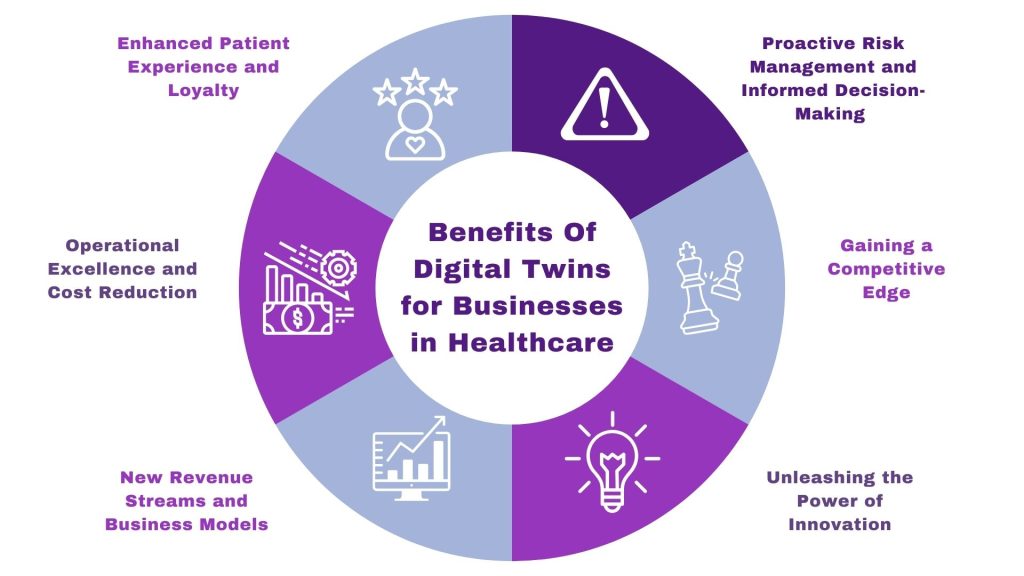
Digital twins are revolutionizing the healthcare landscape, offering exciting opportunities for businesses of all sizes. This technology unlocks a treasure trove of benefits for healthcare organizations:
| Use Case | Primary Benefit | Who Benefits | Outcome |
|---|---|---|---|
| ICU Patient Monitoring | Real-time alerts + predictive deterioration forecasting | Doctors, Nurses | Early intervention + fewer critical emergencies |
| Surgery Planning | Pre-operative rehearsal on patient-specific model | Surgeons, Patients | Higher accuracy + reduced complications |
| Drug Response Simulation | Personalized drug testing without physical trials | Pharma, Patients | Faster and safer drug development |
| Hospital Operations | Predictive bed management & workflow optimization | Hospitals, Admin Teams | Reduced wait times + operational efficiency |
Operational Excellence and Cost Reduction
Digital twins are a powerful tool for streamlining workflows and optimizing processes across healthcare organizations. By simulating and analyzing patient flow, supply chains, and staffing requirements, digital twins pinpoint areas for improvement. They empower data-driven optimization of resource allocation, ranging from hospital beds and operating rooms to specialized medical equipment. This translates directly into significant cost savings, reduction of waste, and improved overall operational efficiency.
Enhanced Patient Experience and Loyalty
Personalized medicine enabled by digital twins is a game-changer. Virtual replicas of patients, built from extensive historical and real-time data, permit highly tailored treatments and preventative care. The ability to predict how a patient’s response to different interventions significantly improves outcomes and fosters patient satisfaction. This leads to increased loyalty, positive word-of-mouth, and an enhanced reputation for the healthcare provider.
New Revenue Streams and Business Models
Digital twins pave the way for innovative healthcare services. Remote monitoring solutions, powered by the real-time data of wearable devices integrated into digital twins, enable patients to get ongoing care from the comfort of their homes. This unlocks new potential revenue streams for healthcare businesses. Additionally, personalized care plans and subscription-based virtual consultation models become viable business strategies.
Unleashing the Power of Innovation
Digital twins foster a culture of experimentation and accelerate R&D by providing a safe virtual sandbox. Medical device companies can iterate rapidly on new designs and test them on digital twins before committing to expensive prototypes. Pharmaceutical companies can simulate the effects of new drugs on virtual patients to refine their research direction. This translates into faster development cycles, reduced costs, and a greater likelihood of bringing breakthrough treatments and technologies to market.
Proactive Risk Management and Informed Decision-Making
Digital twins allow for predictive maintenance of critical medical equipment, identifying potential failures before they disrupt patient care and protecting both patient safety and the business’s reputation. Furthermore, healthcare leaders gain a comprehensive view of potential changes, allowing them to simulate the impacts of new policies, facility layouts, or service offerings before implementation. These features empower informed, data-driven decision-making while mitigating potential risks.
Gaining a Competitive Edge
Healthcare organizations that embrace digital twins position themselves as industry leaders in adopting next-generation technology. Offering cutting-edge, highly personalized care and demonstrating a commitment to innovation not only attracts new patients but also enhances the business’s reputation. This competitive advantage is crucial for establishing a strong market position in the rapidly evolving healthcare landscape.
Real-Life Use Cases of Digital Twins in Healthcare
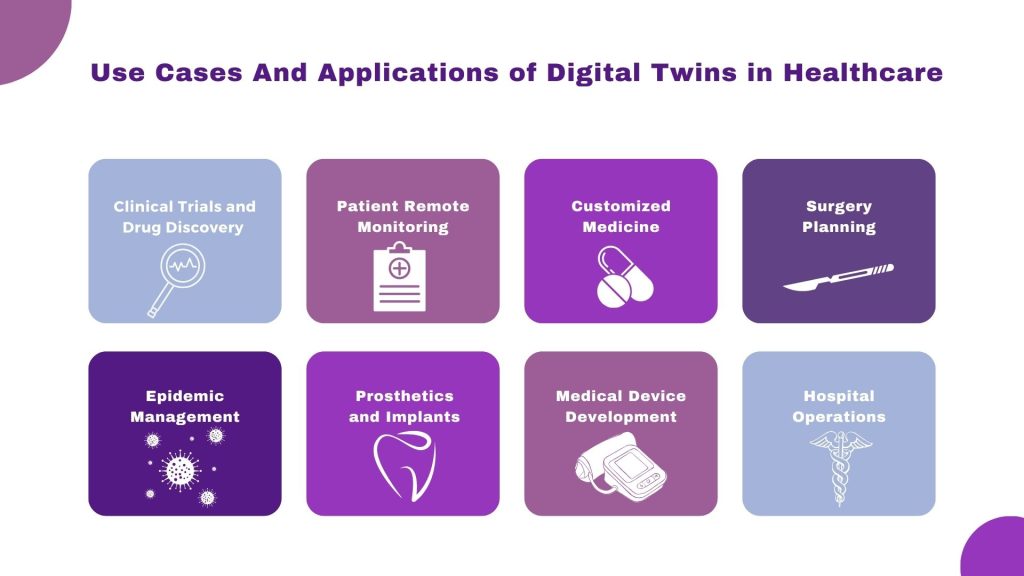
Digital twins are all set to usher in a new era of healthcare innovation. These virtual replicas, seamlessly integrated with real-time data, are already driving advancements in research, clinical practice, and operational efficiency. Let’s delve deeper into key use cases and the cutting-edge projects driving this transformation:
Clinical Trials and Drug Discovery
Digital twins offer researchers a powerful toolkit to streamline and revolutionize how new drugs and therapies are developed with AI integration. Projects like “The Living Heart” by Dassault Systèmes and the “Virtual Patient” initiative by the In Silico World project are simulating various physiological systems with incredible detail. Researchers can test medications on a vast array of virtual patients with varied health profiles, accelerating development timelines and addressing potential health disparities. This could pave the way for safer, more effective medications to reach patients faster.
Patient Remote Monitoring
The integration of wearables, home health monitors, and digital twins is redefining how we care for patients with chronic conditions or in post-acute settings. Platforms such as Current Health and Biofourmis monitor real-time vital signs and other health metrics. AI-powered analytics on digital twins flag potential early warning signs, allowing clinicians to intervene proactively, regardless of the patient’s location. This model not only increases access to care in underserved areas but also empowers patients to actively participate in managing their health, potentially reducing hospitalizations.
Customized Medicine
Digital twins facilitate a new level of treatment personalization. A patient’s health records, lifestyle data, and even genomic profile can be integrated into a comprehensive digital twin. Siemens Healthineers launched this approach in cancer care, enabling physicians to explore a multitude of potential treatment options, from medication to intricate surgical procedures. This tailored approach maximizes effectiveness, reduces the risk of adverse events, and ultimately improves patient experiences and outcomes.
Surgery Planning
Digital twins derived from advanced imaging like CT or MRI scans allow surgical teams to step into a virtual world that mirrors the patient’s anatomy. Innovators like Surgical Theater are offering solutions like Precision VR®, where surgeons can rehearse complex procedures, anticipate challenges, and refine their approach within a realistic digital model. This meticulous pre-surgical planning and simulation boosts surgical confidence, enhances patient safety, and optimizes outcomes, especially in high-risk situations.
Epidemic Management
As we’ve learned from the COVID-19 pandemic, global health crises necessitate rapid, data-driven responses. Digital twins play a critical role in public health, modeling the spread of infectious diseases on a population scale. The Institute for Disease Modeling simulates disease transmission dynamics, providing invaluable data to health authorities at both the local and global levels. These models identify potential hotspots, optimize resource allocation, and help evaluate the effectiveness of interventions, especially amidst critical events like pandemics.
Prosthetics and Implants
Patient-specific digital twins are enhancing how prosthetics and implants are designed and created. Companies like Materialise and UNYQ leverage detailed imaging data to design devices that perfectly conform to an individual’s anatomy. This leads to greater functionality, superior fit, and better cosmetic outcomes, significantly improving the mobility and quality of life for patients.
Medical Device Development
The ability to virtually test medical devices within digital twins accelerates the development of life-saving or life-changing devices. By simulating how a device performs under diverse physiological conditions, engineers can pinpoint weaknesses, optimize design, and quickly iterate. This streamlines the development timeline and increases safety. The FDA’s recognition of simulation-based approval pathways demonstrates the growing importance of digital twins in bringing new devices to market faster.
Hospital Operations
Digital twins are becoming powerful tools for optimizing complex systems like hospital operations. Organizations like Geisinger Health System and the Mayo Clinic are building digital replications of their facilities to model patient flow, bed occupancy, staffing, and logistical needs. These simulations pinpoint bottlenecks, identify areas for efficiency gains, and empower hospital administrators to make data-driven decisions that improve patient flow, reduce wait times, and elevate the overall experience for patients and staff alike.
Challenges and Considerations
While digital twins offer significant potential, it’s crucial to address the hurdles and strategic considerations surrounding their integration into healthcare:
Data Security and Privacy
Digital twins handle highly sensitive patient data. Strong cybersecurity measures and strict obedience to privacy regulations (like HIPAA) are critical for protecting this information. It’s vital to build trust with patients by ensuring transparency around how their data is used and allowing them control over their digital twin.
Data Accuracy and Completeness
Digital twins rely on accurate, real-time data to function effectively. Incomplete or inconsistent data will compromise model outputs and subsequent decision-making. Thorough data quality checks, ongoing validation, and the integration of data from diverse sources, including patient-generated health data, are crucial.
Interoperability Challenges
Healthcare systems often operate on disparate data platforms and lack standardization. Ensuring seamless data exchange between multiple systems is necessary for creating fully functional digital twins. Open standards adoption and industry collaboration are vital to overcome this fragmented landscape.
Scaling Implementation
While pilots show promise, scaling digital twin technology across entire hospitals or healthcare systems presents both technological and logistical challenges. Careful planning, robust IT infrastructure, and change management strategies are essential for achieving widespread adoption.
Cost and Return on Investment (ROI)
Developing and implementing digital twin technology can require substantial investment. Healthcare providers need to carefully weigh the potential benefits against upfront costs and conduct a thorough ROI analysis. Collaboration and resource-sharing models may pave the way for wider accessibility.
Regulatory Landscape
The existing regulatory environment for digital twins in healthcare is still evolving. Clear guidelines and standards regarding their development, validation, and clinical use are needed to facilitate widespread adoption. Collaboration between healthcare providers, technology companies, and regulatory bodies is key in addressing this.
Ethical Considerations
Digital twins raise questions about potential bias, consent, and equity. Algorithms must be rigorously tested to minimize bias, especially when used to predict disease risks or personalized treatment options. Further, clear guidelines on obtaining informed consent for a patient’s digital twin are needed. Open public dialogue, proactive engagement of ethicists, and a focus on patient-centricity will be crucial.
Regulatory, Ethical & Data Privacy Challenges
Implementing digital twins in healthcare introduces several regulatory and ethical considerations.
Data Privacy & Compliance
Hospitals must ensure compliance with HIPAA, GDPR, and local health data protection laws. Since digital twins rely on sensitive patient data, robust encryption, access controls, and anonymization are essential.
Patient Consent & Ethical Use
Patients must fully understand how their data—and their virtual replica—will be used. Ethical frameworks must address:
- Data ownership
- Model accuracy vs clinical risk
- Bias in AI-driven simulations
Regulatory Approval for Clinical Use
Digital twin systems used for diagnosis or treatment simulation may require approval from regulatory authorities such as the FDA. Hospitals must document model performance, reliability, and validation standards.
Key Strategies for Adopting Digital Twins in Healthcare
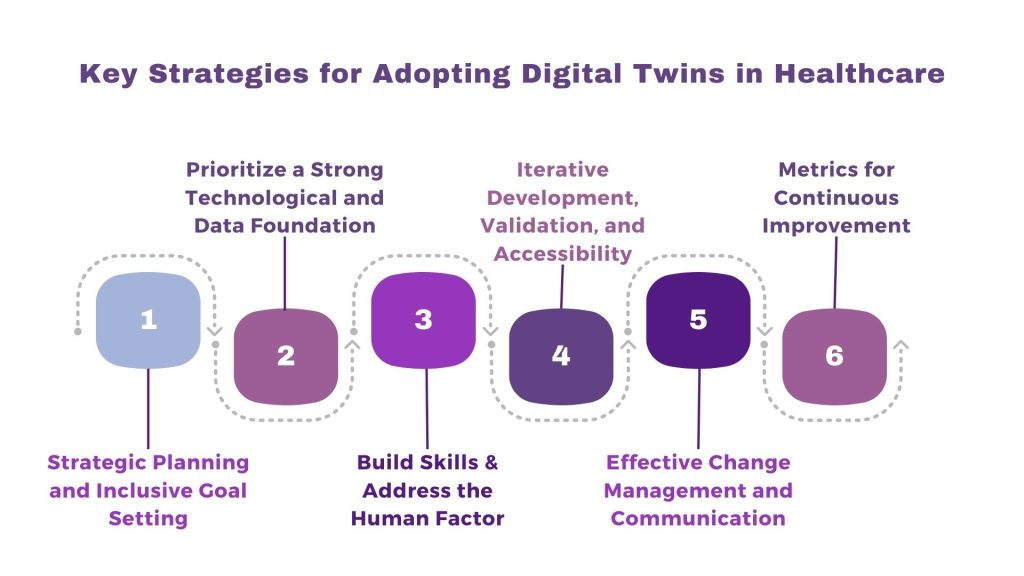
Successful integration of digital twin technology in healthcare requires a strategic approach that prioritizes both technical and human factors. Here’s a breakdown of key strategies:
Strategic Planning and Inclusive Goal Setting
Clearly define the problems you aim to solve with digital twins. Involve diverse stakeholders in this process to ensure solutions reflect the needs of patients, clinicians, and the broader healthcare ecosystem. Assess your organization’s infrastructure, staff readiness, and potential inclusivity barriers. Begin with focused pilots to demonstrate value, build trust, and iteratively scale up implementation.
Prioritize a Strong Technological and Data Foundation
Invest in infrastructure like cloud platforms and data storage solutions that support accessibility. Establish clear privacy protocols, data standardization practices, and robust quality controls. Choose technology partners with proven healthcare expertise and a commitment to inclusive and equitable solutions.
Build Skills & Address the Human Factor
Provide comprehensive training for all staff who will interact with digital twins and offer additional support where needed to ensure no one is left behind. Identify change champions who can promote adoption. Expand your team with specialists in data science, AI, and visualization – make a conscious effort to recruit from diverse backgrounds.
Iterative Development, Validation, and Accessibility
Adopt an agile development methodology, seeking feedback from patients and clinicians throughout the process. Rigorously test and validate digital twin models against real-world data for reliability. Communicate transparently about potential limitations. Design for accessibility from the beginning and create a culture of safe experimentation with digital twins.
Effective Change Management and Communication
Proactively address privacy and ethical concerns with patients and staff, outlining clear safeguards. Involve patients in the development of their digital twins and create transparent consent procedures. Celebrate and share success stories to build momentum and showcase the transformative power of digital twins.
Metrics for Continuous Improvement
Define quantifiable success metrics and track key performance indicators (KPIs) related to your specific use case. Use data insights to refine your digital twin implementation over time. Recognize that technology is evolving, and commit to continuous learning and adaptation.
Important Considerations
Collaboration is crucial. Partner with researchers, other healthcare facilities, and technology leaders, prioritizing inclusivity within these alliances. Stay informed about the ever-evolving regulatory landscape for digital twins in healthcare to ensure compliance and drive continuous innovation.
How Hospitals Can Implement Digital Twins: Step-by-Step Roadmap
Hospitals often struggle with where to start. Here is a practical roadmap:
Step 1: Identify the Use Case
Choose a problem with high impact—such as ICU monitoring, surgical planning, or predictive staffing.
Step 2: Assess Data Availability
Digital twins require large datasets. Hospitals must evaluate the quality and consistency of existing data sources.
Step 3: Select Technology Partners
Choose a development team (like Idea Usher) to build the simulation engine, AI models, and data pipelines.
Step 4: Build & Train the Digital Twin Model
Develop a patient-specific or system-specific virtual replica using historical and real-time data.
Step 5: Validate the Model
Run simulations and compare results with actual outcomes to ensure accuracy.
Step 6: Deploy into Clinical Workflow
Integrate with EHR systems, IoT devices, and hospital dashboards.
Step 7: Continuous Monitoring & Model Updates
Regular updates ensure the digital twin stays accurate as new data comes in.
Future of Digital Twins in Healthcare
Digital twins are expected to transform healthcare at scale over the next decade.
AI-Augmented Diagnostics
AI-powered digital twins will predict disease risks years in advance using biomarkers and genetic data.
Digital Twin Clinical Trials
Pharma companies will test drug interactions on virtual populations before conducting physical trials.
Metaverse Surgical Training
Immersive 3D digital twins will allow surgeons to practice complex surgeries with precision.
Population-Wide Twins
Governments may build digital twin models of entire populations to predict outbreaks or chronic disease patterns.
Conclusion
Digital twins stand to reshape the healthcare business landscape. Beyond improved patient care, they offer significant opportunities for optimizing operations, streamlining research and development, and minimizing risk. However, successful adoption necessitates overcoming challenges surrounding data governance, interoperability, and implementation.
By embracing digital twin technology, collaborating with experts like Idea Usher, and proactively addressing potential hurdles, healthcare businesses can secure a competitive advantage in this rapidly evolving sector. Are you prepared to harness the transformative power of digital twins to elevate your business and reimagine the future of healthcare delivery?
Partnering with Idea Usher
Elevate your healthcare business with the transformative power of digital twins. Unlock actionable insights, streamline operations, and unprecedented efficiency with digital twin technology.
Partner with Idea Usher and gain a strategic advantage in a rapidly evolving industry. Contact us Today!
Work with Ex-MAANG developers to build next-gen apps schedule your consultation now
FAQs
How are digital twins used in practice?
Doctors are already using digital twins to plan complex surgeries, monitor chronic conditions remotely, and even design personalized treatment plans. For instance, a surgeon might use a digital twin of a patient’s heart to practice a valve replacement procedure beforehand.
What problems do digital twins solve?
Digital twins can address several challenges in healthcare. They can improve treatment planning and decision-making, reduce risks associated with surgery, and enable more efficient remote patient monitoring. Additionally, they can accelerate drug development and optimize resource allocation within healthcare systems.
What are the challenges of digital twins in healthcare?
Security and privacy are major concerns. Ensuring patient data stays confidential is crucial. Additionally, creating and maintaining accurate digital twins requires significant computing power and expertise.
How can digital twins be used in healthcare?
The applications are vast! Imagine doctors using digital twins to predict your risk of certain diseases or to personalize medication plans based on your unique biology. Digital twins can also be used to develop new drugs and therapies, streamline surgical procedures, and even train future doctors in a virtual environment.
